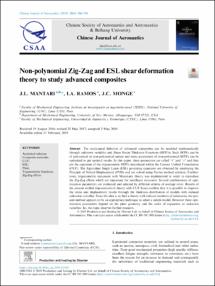| dc.contributor.author | Mantari, J.L | |
| dc.contributor.author | Ramos, I.A | |
| dc.contributor.author | Monge, J.C. | |
| dc.date.accessioned | 2021-03-16T23:23:01Z | |
| dc.date.available | 2021-03-16T23:23:01Z | |
| dc.date.issued | 2019-04 | |
| dc.identifier.issn | 1000-9361 | es_PE |
| dc.identifier.uri | https://hdl.handle.net/20.500.12815/198 | |
| dc.description.abstract | The mechanical behavior of advanced composites can be modeled mathematically through unknown variables and Shear Strain Thickness Functions (SSTFs). Such SSTFs can be of polynomial or non-polynomial nature and some parameters of non-polynomial SSTFs can be optimized to get optimal results. In this paper, these parameters are called “r” and “s” and they are the argument of the trigonometric SSTFs introduced within the Carrera Unified Formulation (CUF). The Equivalent Single Layer (ESL) governing equations are obtained by employing the Principle of Virtual Displacement (PVD) and are solved using Navier method solution. Furthermore, trigonometric expansion with Murakami theory was implemented in order to reproduce the Zig-Zag effects which are important for multilayer structures. Several combinations of optimization parameters are evaluated and selected by different criteria of average error. Results of the present unified trigonometrical theory with CUF bases confirm that it is possible to improve the stress and displacement results through the thickness distribution of models with reduced unknown variables. Since the idea is to find a theory with reduced numbers of unknowns, the present method appears to be an appropriate technique to select a simple model. However these optimization parameters depend on the plate geometry and the order of expansion or unknown variables. So, the topic deserves further research. | es_PE |
| dc.format | application/pdf | es_PE |
| dc.language.iso | eng | es_PE |
| dc.publisher | Elsevier | es_PE |
| dc.rights | info:eu-repo/semantics/openAccess | es_PE |
| dc.rights.uri | http://creativecommons.org/licenses/by-nc-nd/4.0/ | * |
| dc.source | Repositorio Institucional UTEC | es_PE |
| dc.source | Universidad de Ingeniería y Tecnología - UTEC | es_PE |
| dc.subject | Composite materials | es_PE |
| dc.subject | Plates (structural components) | es_PE |
| dc.subject | Plating | es_PE |
| dc.subject | Shear deformation | es_PE |
| dc.subject | Shear strain | es_PE |
| dc.subject | Carrera unified formulations | es_PE |
| dc.subject | Equivalent single layers | es_PE |
| dc.subject | Principle of virtual displacements | es_PE |
| dc.subject | Shear deformation theory | es_PE |
| dc.subject | Stress and displacements | es_PE |
| dc.subject | Thickness distributions | es_PE |
| dc.subject | Trigonometric functions | es_PE |
| dc.subject | Zig-zag effects | es_PE |
| dc.subject | Polynomials | es_PE |
| dc.title | Non-polynomial Zig-Zag and ESL shear deformation theory to study advanced composites | es_PE |
| dc.type | info:eu-repo/semantics/article | es_PE |
| dc.identifier.doi | https://doi.org/10.1016/j.cja.2019.02.001 | es_PE |
| dc.identifier.journal | Chinese Journal of Aeronautics | es_PE |


